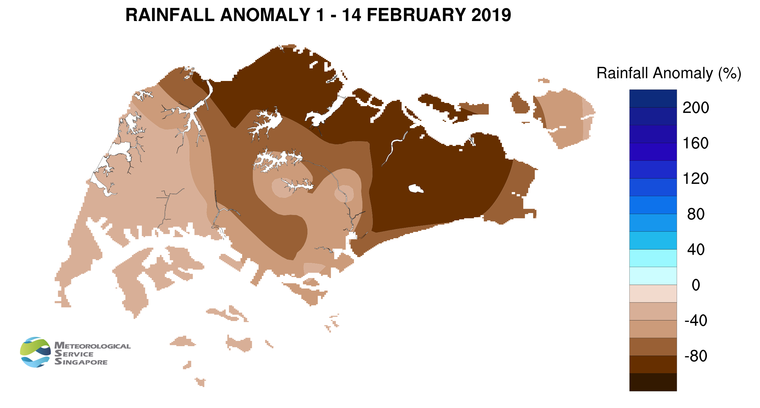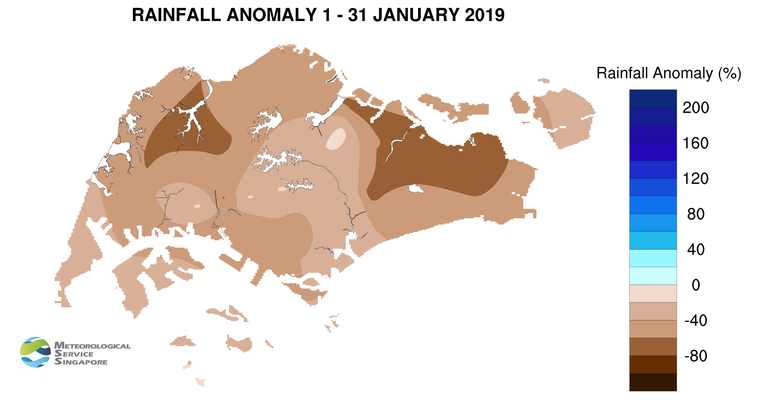For most days in the rest of Feb 2019, dry and warm weather are expected. Some showers expected in the early part of the second fortnight of Feb 2019. Daily max temperature could rise to around 34°C on some days
Singapore, 15 February 2019 – The prevailing dry phase of the Northeast Monsoon season over Singapore and the surrounding region is expected to extend into the second half of February 2019. During the period, the low level winds are forecast to weaken and blow from the north or northeast.
2 In the second half of February 2019, the dry and warm weather experienced over Singapore and the surrounding region in the first fortnight of the month are forecast to persist. This is due to stable atmospheric conditions arising from the presence of a dry air mass over the Southeast Asia region. In the early part of the second fortnight, localized short-duration thundery showers can still be expected in the afternoon on some days due to strong daytime heating of land areas coupled with convergence of winds over Singapore and the surrounding vicinity. The showers could extend into the evening on one or two of these days. Overall, the rainfall for February 2019 is likely to be well-below normal.
3 With dry and warm conditions expected for the rest of the month, the daily maximum temperature could rise to around 34°C especially on days with little or no rain and when winds are light. On most days, the daily temperatures are forecast to range between 24°C and 33°C.
4 For updates of the daily weather forecast, please visit our MSS website (https://www.weather.gov.sg), NEA website (www.nea.gov.sg), or download the myENV app, or the MSS’ Weather@SG app.
REVIEW (1 – 14 February 2019)
5 In the first fortnight of February 2019, Northeast Monsoon conditions prevailed over the Southeast Asia region, including Singapore. During the fortnight, the low level winds over Singapore and the surrounding region were blowing from the north or northeast. In addition, the monsoon rain band was located south of the Equator, and stable atmospheric conditions prevailed over Singapore and surrounding region.
6 Dry and warm weather with occasionally windy conditions prevailed on most days in the first half of February 2019. There were some days where short-duration thundery showers fell over areas in the western half of the island in the late afternoon and on a few days extending into the evening. The thundery showers during the period were not particularly heavy, and the highest total rainfall of 42.4 mm in a day was recorded at Jurong on 4 February 2019. The eastern half of the island was generally dry, and at the climate station in Changi, only 0.2mm of rain was recorded during the first half of the month.
7 The few days around the Lunar New Year holiday period were dry and warm with daily maximum temperatures reaching around 34.3°C at a few stations across the island. The dry and warm weather continued for the rest of the first half of February 2019. The daily maximum temperature recorded during the first fortnight of February 2019 ranged between 33.6°C and 34.8°C. The highest daily maximum temperature of 34.8°C was recorded on 9 February 2019 at Admiralty. The daily minimum temperature recorded in the fortnight ranged between 22.2°C and 24.7°C. The lowest daily minimum of 22.2°C was recorded between the early and predawn hours of 12 February 2019 at Choa Chu Kang.
8 Singapore received significantly below-normal rainfall in the first half of February 2019. The highest rainfall of 56.8mm (21% below average) was recorded at Jurong. Rainfall was lowest at Changi where 0.2mm (100% below average) was recorded.
CLIMATE STATION STATISTICS
Long-term Statistics for February
(Climatological reference period: 1981 – 2010)
| Average daily maximum temperature | 31.7 °C |
| Average daily minimum temperature | 24.3 °C |
| Average monthly temperature | 27.1 °C |
| Average rainfall | 112.8 mm |
| Average number of rain days | 8 |
Historical Extremes for February
(Rainfall since 1869 and temperature since 1929)
| Highest monthly mean daily maximum temperature: | 33.5 °C (2010) |
| Lowest monthly mean daily minimum temperature: | 21.6 °C (1930, 1934) |
| Highest monthly rainfall ever recorded: | 566.7 mm (1910) |
| Lowest monthly rainfall ever recorded: | 0.2 mm (2014) |

